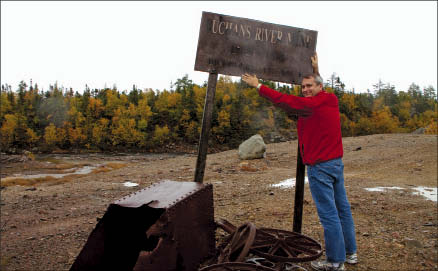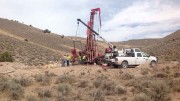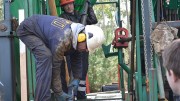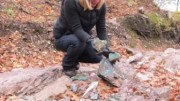The old Buchans mine headframe still stands tall at the end of Main Street in this small Newfoundland town. The structure is a constant reminder for the 750 or so residents that the town’s history is inextricably linked to mining.
For Buchans Minerals (BMC-V), however, the headframe is a symbol of the town’s future. The company wants to revive the old mine with a storied past by tapping into lower-grade material and accessing it by open pit.
The Buchans mine was opened in 1926 by the American Smelting and Refining Company (Asarco). It was one of the first mines to make use of selective flotation technology to extract lead, zinc and copper from what had previously been uneconomic sulphide ore. And Hans Lundberg, who discovered the main deposit, was one of the first to find a deposit using nascent electromagnetic tools with an equipotential line-method survey.
As for mining itself, Buchans is notable for having been one of the highest grade lead-zinc-copper mines in Canada. Asarco mined 16.2 million tonnes grading 14.51% zinc, 7.56% lead, 1.33% copper, 126 grams silver and 1.37 grams gold from five deposits at the Buchans camp over 58 years.
The high-grade deposit justified Asarco carving out the town of Buchans from the untamed Newfoundland wilderness, building very much a company town. Only company housing and merchants were allowed, with housing set out grid-like, and each house allotted a shed at the edge of town. For years the town was only accessible by a 37-km rail line, requiring company permission to come and go.
Today, the town sits at the end of a 70-km, well-paved road off the TransCanada Highway. Since the mine closed in 1984, the area has seen little to fill the gap in the economy, except for the underground Duck Pond mine that Aur Resouces [since acquired by Teck Resources (TCK-T, TCK-N)] opened in 2007 that sits 50 km away and employs some 40 locals, while the town itself looks to have changed very little.
“It’s kind of like stepping back in time when you go to Buchans,” Warren MacLeod, president and CEO of Buchans, said by phone.
The mine site is still littered with rusting iron scraps, derelict buildings slowly falling apart, old machines and, of course, the towering headframe. The provincial government began capping dry tailings and reinforcing the tailings pond, but the job is far from done. MacLeod explained that building the new mine on the old site will be a win-win.
“The idea here is to lessen any sort of environmental impact of getting a new mine up and running by not putting it on a green site,” MacLeod says, “and by putting it on brown sites, we can actually improve the environment.”
With the town originally built to serve the mine, housing and infrastructure were put quite close to the old deposit. For Buchans Minerals, this means not only will it have to move the Royal Canadian Mounted Police office, a local inn and a few houses, but it will have to take extra measures to isolate the effects of the open pit from the town it will abut against.
But so far the town is generally approving of the project, and local politicans are on board.
“As a council we’re fully supportive,” Mayor Derm Corbett said by phone. “We’ve been dealing with this company for a number of years. We find them to be great people – very professional.”
Buchans Minerals hosted a packed public meeting about the project in the summer and, while people had concerns about dust, noise and vibrations, Corbett says they were largely supportive.
“There are certainly issues they have concerns about, but as far as I could see at the meeting there was a great deal of support,” Corbett says.
For MacLeod, public consultations is just one way he’s tried to bring momentum to the project since joining the company in mid-2010. As well as bringing new focus to Buchans, he has led an expansion of regional exploration, and the acquisition of a New Brunswick manganese project.
Earlier this year MacLeod had the company stretch an inferred resource into a preliminary economic assessment (PEA) to get hard numbers on the table. The PEA incorporated 17.3 million inferred tonnes grading 1.63% zinc, 0.69% lead, 0.4% copper and 5.96 grams silver in an open-pit design out of the 22 million tonnes of
inferred resources sitting in the Lundberg and Engine House
deposits.
The Lundberg deposit consists of quartz-barite-carbonate sulphide veins and veinlets cutting strongly altered mafic volcanics with disseminated sulphides. Mineralization typically occurs with fine- to coarse-grained euhedral pyrite as the dominant sulphide and occurs with varying amounts of chalcopyrite, sphalerite, galena and barite.
The top of the resource sits under and around the old mine buildings, with almost no overburden.
“You could take a broom and sweep it off,” Paul Moore, vice-president of exploration at Buchans, said of the overburden as he toured The Northern Miner around the project during a dreary day of rain, wind and cold.
The deposit plunges downward to the southwest so the overall strip ratio is a less impressive 3.06-for-1, but MacLeod notes that it still makes for good economics.
“The key feature to that project is the low stripping ratio on the open-pit,” MacLeod says, “which basically results in a revenue to cost ratio of the life-of-mine of about two for one.”
Overall, operating costs are estimated at $23.79 per tonne and net revenue works out to $53.95 per tonne for the 2.2-for-1 ratio, while for the first five years the ratio is 2.5-for-1. Total capital costs, including a $56-million processing plant and a $17-million tailings pond, come in at $119.6 million, with a 1.4-year payback, while sustaining costs are $32.4 million.
The study outlined a 10-year, 5,000-tonne-per-day mine, producing annual concentrate volumes of 27.1 million lbs. zinc, 5.5 million lbs. copper, 16.3 million lbs. lead and 47,900 oz. silver. All together, the financials work out to a pre-tax net present value of $217.8 million using a 6% discount rate and an internal rate of return of 44%.
The PEA was based on US$1.22 per lb. zinc, US$3.62 per lb. copper, US$1.10 per lb. lead and US$22.74 per oz. silver. However, lead and zinc recently traded around 85¢-90¢ per lb.
The study was preliminary in a number of ways, the most glaring being that it was based entirely in inferred resources. The project requires more drilling to bring resources into measured and indicated before the company could move ahead to a prefeasibility study, but MacLeod doesn’t plan to do it alone.
“We’re not going to do that ourselves with our money,” MacLeod says, explaining the company’s overall strategy of spending as little as possible to make the projects attractive to potential partners.
With Buchans trading at between 5¢ and 8¢ over the past few months, after a short spike to 17¢ on a gold discovery at its Long Range project in Newfoundland, raising capital becomes quite dilutive and the company wants to avoid it. The company already has 151 million shares outstanding, plus 8 million options and 34 million warrants.
So instead, MacLeod wants to joint venture, option, spin out or otherwise advance both the Lundberg project and its Woodstock manganese project so that Buchans does not have to single-handedly advance them and spend its own money. The PEA was a way to better market the project, as was the drilling the company recently completed at its Woodstock project.
At Woodstock, the company completed a few drill holes to show the reliability of drilling from the 1980s, which had established a conceptual, non-compliant resource of around 46 million tonnes grading 11% manganese at the Plymouth deposit. But what sold Buchans on the project was a government study that showed the potential to recover 80% of the manganese through heap leaching.
“As soon as we saw that we immediately acquired the pr
operty, and we’ve now just completed five holes in the Plymouth deposit,” MacLeod says.
Results from the drilling included 101 metres grading 11.27% manganese from 10 metres depth, 78 metres grading 12.51% manganese from 69 metres depth and 89 metres carrying 11.43% manganese.
While not enough for a new resource, the results at least established the reliability of the old drill data.
For MacLeod, the biggest question on the project is the metallurgy, not the resource. The company is waiting for heap-leach testing results that will give it a better sense of the project’s
potential.
“Down in China their average recoveries are around seventy-two percent, so if we’re getting those kind of recoveries or better, then we’d be very happy with that,” MacLeod says.
MacLeod sees strength in the electrolytic manganese market, with possible production constraints in the future. Like some other specialized commodities, China controls 97% of the production, and MacLeod says producers there have been hit by high electricity tariffs because processing is so energy intensive.
“Probably the biggest benefit to this project is it’s close to a stable and cheap power supply,” MacLeod says of Woodstock.
“The scale of it could be significantly bigger than our Lundberg project, but obviously we’ve got a lot of work to do to get solid numbers that we can actually put in the public domain.”
Besides the Lundberd and Woodstock, the company is also exploring around the Long Range project southwest of Lundberg in Newfoundland. Buchans has a fifty-fifty joint venture on Long Range with Benton Resources (BTC-V).
Back in January the company raised some excitement after sampling up to 106.4 grams gold and 364.3 grams silver in float samples at the Goldquest prospect. The company recently started an 8-hole, 875-metre drill program to follow up on that discovery, testing the mineralized quartz veins on the 750-metre-long trend.
More recently, Buchans found a new area of gold-bearing quartz float some 26 km east at what is now called the Goldrange project. Four samples came back with significant gold and silver grades, including 25.8 grams gold and 130.2 grams silver, and 20.6 grams gold and 87.1 grams silver.
The gold discoveries and manganese project have brought new room for growth in the company, but as they are still at such early stages, Lundberg is still the company’s flagship.
Lundberg is also a focus because it could become the centre of a larger area play. Buchans controls several other properties in the area with varying amounts of work done that could become satellite deposits feeding the central infrastructure.
“We view Lundberg as a regional play that will happen in that area,” MacLeod says, noting the already established Daniels Pond resource, the Tulks Hill deposit and the Clementine West and Buchans North targets closer to the Buchans mine, which could all potentially feed a central mill.
But before any of that happens, Buchans Minerals needs to find a partner or two to help bring its projects forward.
MacLeod says he’s had a number of inquiries already, and has self-imposed a year-end deadline to make a deal, which might mean that the Buchans mine is still building its history.






Be the first to comment on "Buchans Minerals revives historic mine"